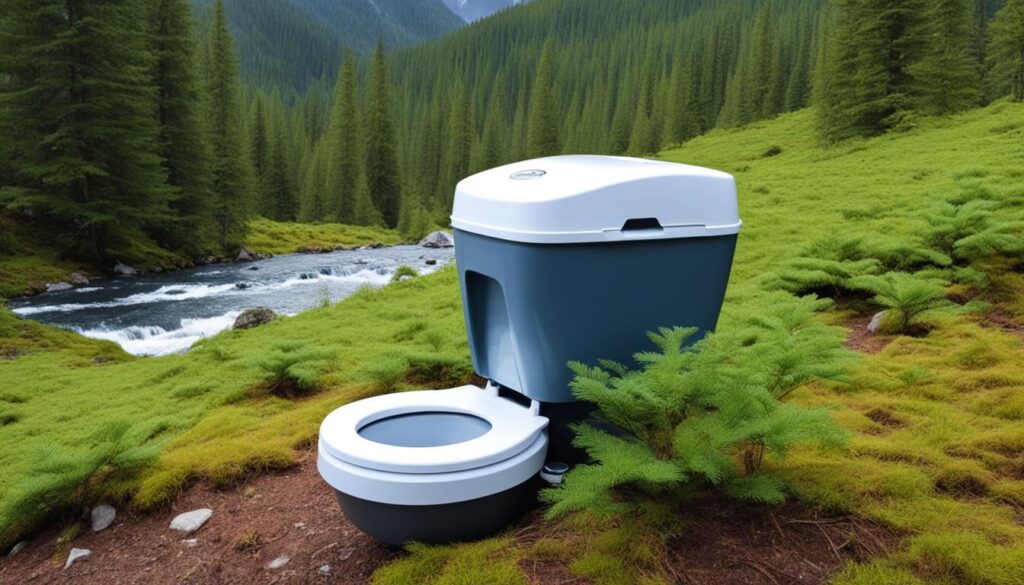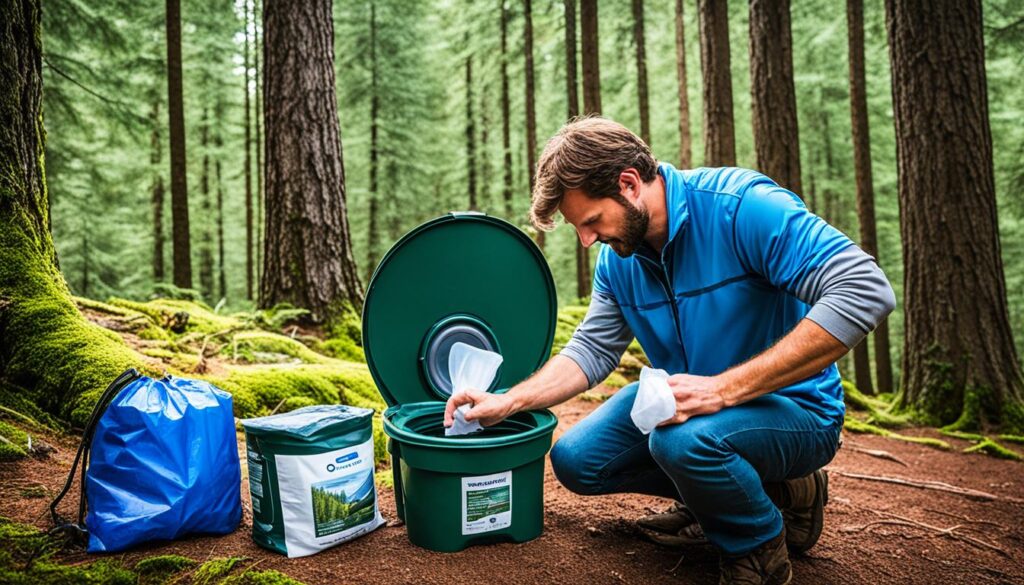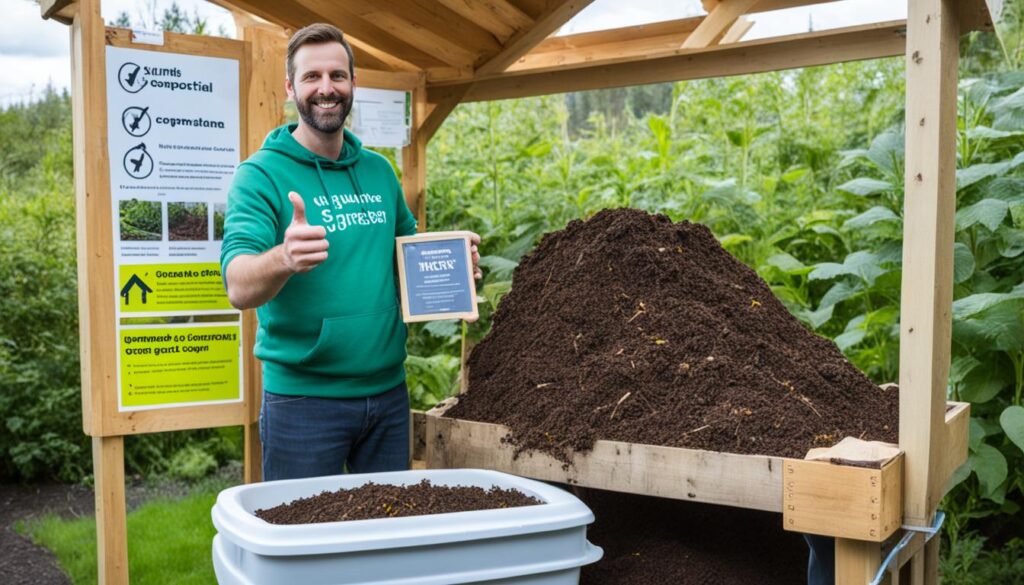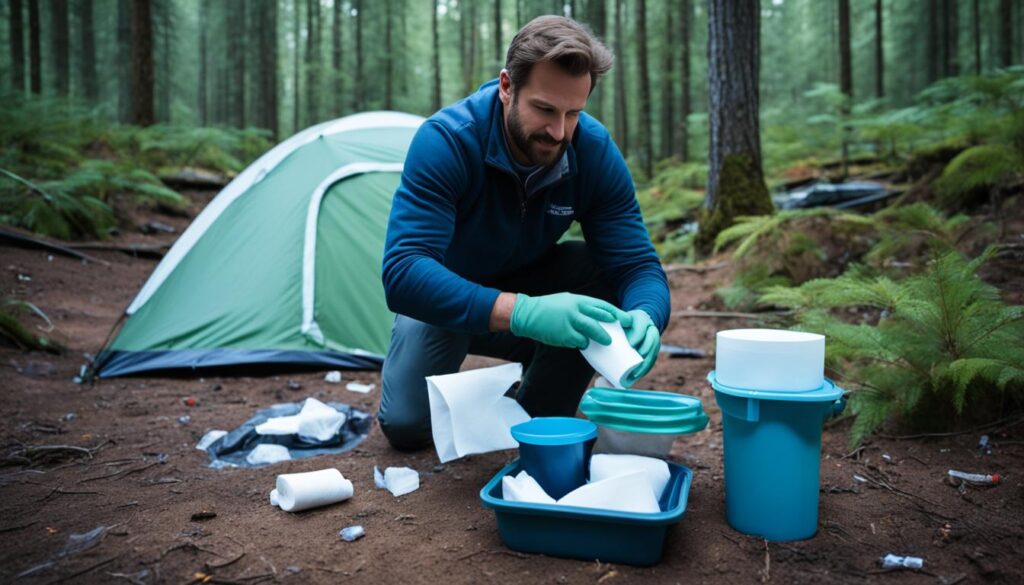Are you tired of relying on public or vault toilets while camping? Creating your own DIY camping toilet can provide you with convenience and independence. Whether you opt for a separating toilet or an all-in-one design, making a portable camping toilet is a cost-effective solution that can enhance your camping experience.
A separating toilet, also known as a composting toilet, offers the advantage of separating liquid waste from solid waste. It uses a composting medium for solid waste and ensures odor-free disposal. On the other hand, an all-in-one camping toilet combines both types of waste in one container. Although it may have a stronger smell, it’s a budget-friendly option that eliminates the need for separate waste disposal.
So, let’s dive into the world of DIY camping toilets and explore the benefits of each design so that you can make an informed decision based on your camping preferences.
Key Takeaways:
- A DIY camping toilet is a great alternative to public or vault toilets while camping.
- A separating toilet, or composting toilet, separates liquid waste from solid waste for easier disposal.
- An all-in-one toilet combines both types of waste in one container, providing a budget-friendly option.
- Separating toilets are odor-free and cost-effective compared to pre-made composting toilets.
- All-in-one toilets are easy to make and require frequent emptying.
Contents
Benefits of a Separating Toilet (Composting Toilet)
Separating toilets, also known as composting toilets, offer numerous benefits for campers and outdoor enthusiasts. These innovative toilet systems are designed to separate liquid and solid waste, providing a more efficient and eco-friendly solution compared to traditional camping toilets.
One of the key advantages of separating toilets is their ability to eliminate odors. By separating liquid waste from solid waste, these toilets prevent the mixing of fluids that can lead to unpleasant smells. The solid waste is deposited into a container filled with a composting medium, such as sawdust or peat moss, which helps to control odors and facilitate decomposition.
In addition to odor control, separating toilets also make waste disposal much easier. With separate containers for liquid and solid waste, campers can dispose of the waste appropriately and in compliance with camping regulations. The liquid waste can be diverted into a separate container, while the solid waste can be disposed of as regular garbage or buried. This flexibility allows campers to choose the most suitable method of waste disposal based on their location and environmental considerations.
Another significant advantage of separating toilets is their cost-effectiveness, especially when compared to pre-made composting toilets. DIY separating toilets can be assembled using readily available materials and components, making them a more budget-friendly option for campers. This affordability factor makes separating toilets accessible to a wide range of outdoor enthusiasts who are looking for an eco-friendly and sustainable camping toilet solution.
Furthermore, separating toilets require less frequent disposal of solid waste compared to other camping toilet options. The composting medium used in these toilets facilitates the natural decomposition process, reducing the volume of solid waste over time. As a result, campers can enjoy longer camping trips without the need for frequent waste disposal, enhancing their overall convenience and comfort.
To summarize, separating toilets, or composting toilets, provide numerous benefits for campers seeking an eco-friendly camping toilet solution. From eliminating odors to facilitating waste disposal and offering cost-effectiveness, these toilets offer a practical and sustainable option for outdoor enthusiasts.
Benefits of an All-In-One Camping Toilet
An all-in-one camping toilet is a practical and budget-friendly solution for campers looking to create their own portable restroom. Combining both liquid and solid waste in one container, these DIY all-in-one toilets are easy to make and cost-effective, typically requiring less than $10 in materials.
To make an all-in-one camping toilet, you will need a 5-gallon bucket, garbage bags to line the bucket, and a medium such as cat litter or sawdust to absorb odors and solid waste. Simply line the bucket with the garbage bag or two and fill it with the chosen medium.
Note: The strength of the smell may be more noticeable with all-in-one toilets since the liquid and solid waste are combined. However, with proper maintenance and regular emptying, this should not pose a significant issue.
All-in-one toilets offer a convenient and portable option, especially for last-minute camping trips or those on a tight budget. These toilets can be easily emptied every 1-2 days, ensuring cleanliness and hygiene during your camping adventure.

How to Make an All-In-One Camping Toilet
Making an all-in-one camping toilet is a quick and simple process that can provide convenience during your outdoor adventures. By following a few DIY steps, you can create a practical portable toilet to ensure a more comfortable camping experience.
Here are the supplies you’ll need:
- 5-gallon bucket
- Garbage bags
- Pool noodle
- Sawdust or cat litter
Start by cutting the pool noodle to fit around the rim of the 5-gallon bucket. This will provide added comfort and stability when using the toilet.
Pro Tip: Choose a pool noodle that matches the circumference of the bucket, ensuring a snug and secure fit.
Next, line the bucket with a garbage bag, making sure it covers the entire interior surface. This will help with waste disposal and minimize cleaning needs.
- Place a layer of sawdust or cat litter at the bottom of the bucket. This will help absorb any liquids and control odors.
- Secure the pool noodle around the rim of the bucket.
Your DIY all-in-one camping toilet is now ready to use! Simply sit on the toilet seat (you can purchase a separate camping toilet seat or use a suitable alternative), and dispose of waste into the bag-lined bucket. Remember to seal and properly dispose of the waste bag as needed.

Here’s a step-by-step breakdown of how to make an all-in-one camping toilet:
- Cut a pool noodle to fit around the rim of the 5-gallon bucket.
- Line the bucket with a garbage bag.
- Add a layer of sawdust or cat litter as a medium.
- Secure the pool noodle around the rim of the bucket to provide comfort and stability.
With these simple steps, you can create your own DIY all-in-one camping toilet, ensuring a more comfortable and convenient experience during your outdoor adventures.
How to Make a Separating (Composting) Camping Toilet
Making a separating camping toilet is a slightly more involved process compared to an all-in-one toilet. However, with the right supplies and steps, it can be easily accomplished. Here’s a detailed guide on how to make your own separating camping toilet:
Gather the Supplies
To make a separating camping toilet, you will need the following supplies:
- 5-gallon bucket
- Urine diverter
- Gallon jug
- Wood box (to accommodate the bucket and urine diverter)
- Composting medium (such as sawdust or peat moss)
- Toilet seat
- Garbage bag
These supplies are essential for building a functional separating camping toilet. Ensure that you have all the necessary items before proceeding with the construction.
Construct the Toilet
Follow these steps to assemble your separating camping toilet:
- Place the 5-gallon bucket and urine diverter inside the wood box, ensuring that they fit securely.
- Install the urine diverter in a way that diverts liquid waste into the gallon jug. This helps keep the solid waste dry and aids in the composting process.
- Line the toilet bucket with a garbage bag to make waste disposal easier.
- Fill the bucket with a composting medium, such as sawdust or peat moss. This medium helps absorb moisture and promotes the composting process.
- Attach a toilet seat securely to the wood box, making it comfortable and functional.
- Close the lid of the toilet box to complete the construction of your separating camping toilet.
Using the Separating Camping Toilet
“A separating camping toilet offers the convenience of segregating liquid and solid waste, reducing odors and simplifying waste disposal.”
To use the separating camping toilet, simply open the lid, sit on the toilet seat, and proceed as you would on a regular toilet. The urine will flow into the gallon jug through the urine diverter, while the solid waste will accumulate in the bucket with the composting medium. Remember to always line the bucket with a garbage bag for easy waste removal and cleaning.
When the solid waste bucket is full, empty it according to local camping regulations. The liquid waste can be emptied separately from the gallon jug. Properly disposing of the waste ensures a clean and responsible camping experience.

Pros and Cons of a Separating Camping Toilet
| Pros | Cons |
|---|---|
| Segregates liquid and solid waste, reducing odors | Requires more supplies and construction effort compared to an all-in-one toilet |
| Promotes composting of solid waste | May require more frequent emptying than an all-in-one toilet |
| Eco-friendly camping toilet option | Initial setup may have a higher cost |
| Offers convenience and self-sufficiency during camping trips | May require additional maintenance and care |
A separating camping toilet provides several advantages for campers who prioritize cleanliness, eco-friendliness, and convenience. However, it’s important to consider the additional steps and supplies required in comparison to an all-in-one toilet. Choose the option that best suits your camping needs and preferences.
Tips for Using and Maintaining a Camping Toilet
To properly use and maintain a camping toilet, there are a few important tips to keep in mind. First and foremost, it is crucial to empty the toilet regularly, taking into consideration both your usage and the capacity of the container. This will help prevent unpleasant odors and potential overflow.
When it comes to disposing of solid waste, you have a couple of options. Depending on the camping regulations in your area, you can either dispose of it as regular garbage or bury it properly. Make sure to follow the designated waste disposal guidelines to protect the environment and maintain a clean campsite.
After emptying the camping toilet, it’s essential to clean it thoroughly. Use a mild detergent and water to sanitize the toilet, ensuring all surfaces are clean and free from any residue. Additionally, make sure to replace the waste bags or liners on a regular basis to prevent any leaks and maintain hygiene.
Finally, always remember to follow proper hygiene practices when using a camping toilet. Wash your hands thoroughly with soap and water before and after using the toilet to minimize the risk of contamination. By following these tips and maintaining a responsible approach, you can ensure a clean and comfortable camping experience.
FAQ
What is a DIY camping toilet?
A DIY camping toilet is a portable toilet that campers can make themselves to use during their camping trips.
What are the benefits of a separating (composting) toilet?
A separating toilet eliminates odors, makes waste disposal easier, and is cost-effective compared to buying a pre-made composting toilet.
What are the benefits of an all-in-one camping toilet?
An all-in-one camping toilet is a convenient, inexpensive option for campers and can be made easily using common supplies.
How do I make an all-in-one camping toilet?
To make an all-in-one camping toilet, you will need a 5-gallon bucket, garbage bags, a pool noodle, and a medium such as sawdust or cat litter.
How do I make a separating (composting) camping toilet?
To make a separating camping toilet, you will need a 5-gallon bucket, a urine diverter, a gallon jug, a wood box, a composting medium, and a toilet seat.
How do I properly use and maintain a camping toilet?
It is important to empty the toilet regularly, clean it with mild detergent, and follow proper hygiene practices. Waste should be disposed of according to camping regulations.






